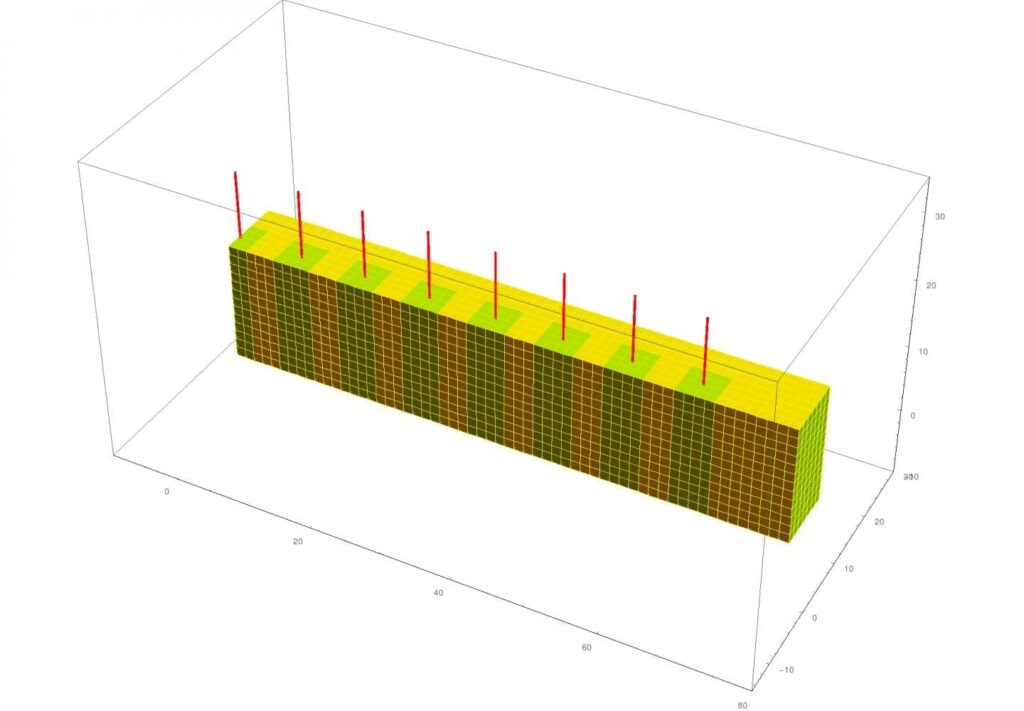
In order to create a material that is both strong and malleable and displays different behavior when exposed to more than one stimulus, researchers embedded light-responsive fibers, which are coated with spirobenzopyran (SP) chromophores, into a temperature-sensitive gel. This new material displays distinctly different behavior in the presence of light and heat.
CREDIT
University of Pittsburgh
Combining photo-responsive fibers with thermo-responsive gels, researchers at the University of Pittsburgh’s Swanson School of Engineering and Clemson University have modeled a new hybrid material that could reconfigure itself multiple times into different shapes when exposed to light and heat, allowing for the creation of devices that not only adapt to their environment, but also display distinctly different behavior in the presence of different stimuli.
Computational modeling developed by Anna C. Balazs, Distinguished Professor of Chemical and Petroleum Engineering at Pitt, and Olga Kuksenok, Associate Professor of Materials Science and Engineering at Clemson, predicted these composites would be both highly reconfigurable and mechanically strong, signaling a potential for biomimetic four-dimensional printing. Their research, “Stimuli-responsive behavior of composites integrating thermo-responsive gels with photoresponsive fibers,” was recently published in the journal Materials Horizons, published by the Royal Society of Chemistry (DOI: 10.1039/C5MH00212E).
“In 4D printing, time is the fourth dimension that characterizes the structure of the material; namely, these materials can change shape even after they have been printed. The ability of a material to morph into a new shape alleviates the need to build a new part for every new application, and hence, can lead to significant cost savings,” Dr. Balazs explained. “The challenge that researchers have faced is creating a material that is both strong and malleable and displays different behavior when exposed to more than one stimulus.”
Drs Balazs and Kuksenok resolved this issue by embedding light-responsive fibers, which are coated with spirobenzopyran (SP) chromophores, into a temperature-sensitive gel. This new material displays distinctly different behavior in the presence of light and heat.
“If we anchor a sample of the composite to a surface, it will bend in one direction when exposed to light, and in the other direction when exposed to heat,” Dr. Kuksenok said. “When the sample is detached, it shrinks like an accordion when heated and curls like a caterpillar when illuminated. This programmable behavior allows a single object to display different shapes and hence functions, depending on how it is exposed to light or heat.”
The researchers note that by localizing the SP functionality specifically on the fibers, the composites can encompass “hidden” patterns that are only uncovered in the presence of light, allowing the material to be tailored in ways that would not be possible by simply heating the sample. This biomimetic, stimuli-responsive motion could allow for joints that bend and unbend with light and become an essential component for new adaptive devices, such as flexible robots.
“Robots are wonderful tools, but when you need something to examine a delicate structure, such as inside the human body, you want a “squishy” robot rather than the typical devices we think of with interlocking gears and sharp edges,” Dr. Balazs said. “This composite material could pave the way for soft, reconfigurable devices that display programmed functions when exposed to different environmental cues.”
Read more: Hybrid material presents potential for 4-D-printed adaptive devices
The Latest on: 4-D-printed adaptive devices
[google_news title=”” keyword=”4-D-printed adaptive devices” num_posts=”10″ blurb_length=”0″ show_thumb=”left”]
via Google News
The Latest on: 4-D-printed adaptive devices
- Fizik Antares Adaptive Reshapes Saddle that Started Fizik’s 3D-Printed Padding Boomon April 24, 2024 at 11:39 am
Fizik call their new Antares Adaptive the latest expansion of their 3D-printed saddle offering. But it’s a bit more than that, as the pro-tour-proven Antares… The post Fizik Antares Adaptive Reshapes ...
- AMD rolling out new adaptive SoCson April 23, 2024 at 2:37 am
AMD’s rolling out a couple of new adaptive SoCs – the Versal AI Edge Series Gen 2 for AI-powered embedded systems and the Versal Prime Series Gen 2 for more traditional embedded systems.
- UltiMaker Launches Factor 4: Reliable and Repeatable 3D Printing for Industryon April 19, 2024 at 8:51 am
As you might expect, the Factor 4 is directly integrated into UltiMaker’s wide materials ecosystem. From UltiMaker Cura, operators can directly access print parameters for a wide variety of third ...
- Advancements in Flexible and Adaptive Electronics A Breakthrough Material for Wearables and Sensorson March 20, 2024 at 2:39 am
In today’s fast-paced world, where technology plays an increasingly integral role in our lives, the demand for flexible and durable electronic materials has never been higher. From smartwatches to ...
- The Best All-in-One Printerson January 6, 2024 at 7:53 pm
We could clearly read text down to 3.5 points, in contrast to the HP 9015e’s legibility down to 4 points. Its graphics are crisper, with minimal banding, than what you’d get out of a printer ...
- Could The Next Tech Unicorn Be Hiding In A Forest Of Patents?on October 7, 2023 at 6:43 am
China's contributions remain relatively small at 4% ... (polymer 3D printing), Relativity Space (metal materials and methods), Seurat Tech (3D printers and methods), Adaptive 3D Tech (polymer ...
- Czinger 21C First Ride Review: 3D-Printed Absurdityon August 19, 2022 at 12:04 pm
Czinger quotes a 0-to-62-mph time of 1.9 seconds, and the 21C takes just 8.5 seconds to reach 186 mph from a stop, asking only 5.4 seconds more ... the 21C has been 3D printed with the help ...
- 3D Printed Battery Pack Keeps Old Drill Spinningon January 29, 2018 at 3:32 am
Eventually, that little adapter cable or oddball battery pack isn’t going to be available anymore, and you’re stuck with a device that ... he decided to 3D print his own battery pack.
- 3D Printing at the Libraryon February 7, 2017 at 6:46 pm
Funded in part by multiple C2E2 Grants (Century II Endowed Equipment ... the variety of printers, tools, and filaments. Schedule your print time here 2024 Spring semester 3D Print schedule start times ...
- Homemade Nerf Blasters With 3D Printed Partson August 28, 2014 at 1:36 am
It is complete with 3D printed parts in a variety of colors. The Extension Spring/Latex Tubing (ESLT) Blasters were based off of [Kane]’s snapoid trigger design with 1/4″ aluminum for the ...
via Bing News







